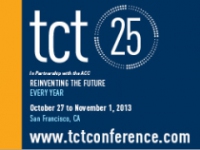TCT 2013.
The full coverage of TCT 2013, that takes place in San Francisco City from October 27th to November 1st .
Partnership Session:
Optimizing PCI Outcomes: SOLACI in Partnership with TCT
- Date: Monday, October 28
- 6:00 pm - 8:00 pm
- Room: Moscone West, 3rd Floor, Room 3010
Moderators: Martin B. Leon, Jamil Abdalla Saad, Gregg W. Stone
Discussants: Jorge Gaspar, Jose L. Leiva-Pons, Jose Armando Mangione, Rogerio Sarmento-Leite
6:00 pm Selecting the Best Antiplatelet Strategy for ACS and Stable CAD (Oscar A. Mendiz)
6:10 pm Discussion
6:15 pm Making the Case for FFR/iFFR Use in >50% of Cases Before PCI (Augusto D. Pichard)
6:25 pm Case Presentation: FFR/iFR Radically Changed How I Treated This Patient (Case Presenter: Pedro A. Lemos)
6:34 pm Discussion
6:39 pm Making the Case for IVUS Use in >50% of Cases During (Soo-Jin Kang)
6:49 pm Case Presentation: IVUS was Essential to This PCI (Case Presenter: Ricardo A. Costa)
6:58 pm Discussion
7:03 pm How Should OCT Be Used in a Busy Cath Lab to Improve Clinical Outcomes (Pedro R. Moreno)
7:13 pm Case Presentation: OCT as Instrumental in Understanding This Case (Case Presenter: Akiko Maehara)
7:22 pm Discussion
7:27 pm Practical Suggestions for Imaging Modalities to Guide Bioresorbable Scaffold Deployment and Follow-Up Assessment (Robert-Jan van Geuns)
7:37 pm Case Presentation: Novel Imaging Insights After BVS Implantation Acute and Chronic (Case Presenter: Hector M. Garcia-Garcia)
7:46 pm Discussion
7:51 pm How Can I Adapt FFR/IVUS/OCT to LATAM Practice? (Rogerio Sarmento-Leite)
If you cannot view the articles, click here






















